It was a dark and stormy night when I left the land of the big PX for Vietnam. I arrived in April 1969. Prior to getting to Vietnam I had talked to several people at the Processing Center at Ft. Lewis, Washington who had been in-county. They told me that the first thing you would notice was the smell.
Well, it wasn't the smell I first noticed as much as the HEAT. Our flight arrived at Cam Rahn Bay at about 0600. At 0605 I started to melt! The heat starts early in Vietnam. We were placed on buses at the airfield and were taken to the Replacement Center. On our drive I thought it unusual that there were Vietnamese civilians along the roadways inside the perimeter. But, oh well, at least they weren't shooting at us...yet...and of course there was steel mesh on the windows to keep us safe. (Really?)
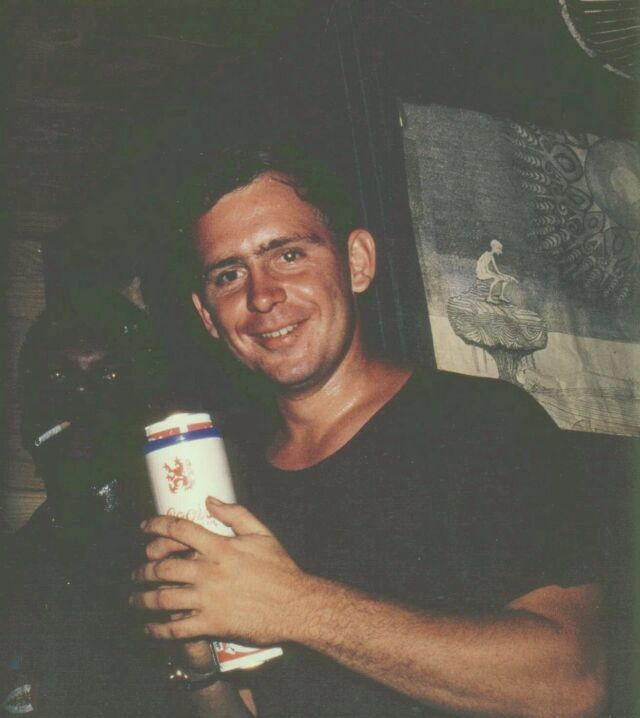 I was processed in-county, then I was assigned to the 23rd Infantry Division (Americal) at Chu Lai. Of course, not from being around there, I ask, "Where is or what is a Chu Lai?" I was simply told it was up north and I could find it on the map. Well I let my fingers do the walking and I finally did find Chu Lai (or Chicken Little as it was more often called). I thought, this isn't bad. It's on the beach. This is going to be a piece of cake. Being in my own little delusional world, I didn't consider the fact that I might not actually spend my time at Chu Lai--on the beach.
I was processed in-county, then I was assigned to the 23rd Infantry Division (Americal) at Chu Lai. Of course, not from being around there, I ask, "Where is or what is a Chu Lai?" I was simply told it was up north and I could find it on the map. Well I let my fingers do the walking and I finally did find Chu Lai (or Chicken Little as it was more often called). I thought, this isn't bad. It's on the beach. This is going to be a piece of cake. Being in my own little delusional world, I didn't consider the fact that I might not actually spend my time at Chu Lai--on the beach.
I got back on the bus and took the ride back to the airfield. There I found a flight headed to Chu Lai. At this point I felt it strange that I was in a combat zone and I had to get around by myself, like I was going on a vacation to Wally World.
Second thought, maybe this was Wally World.
I arrived in Chu Lai and hitched a ride to the Americal's relacement company. Guess what? IT is on the beach! All right, life is good.
After a week of training I was assigned to the 174th Assault Helicopter Company (AHC) in Duc Pho. Again I asked, "What is or where is a Duc Pho?" I was told that it was the 11th Brigade's Firebase southwest of here (Chicken Little). Duc Pho was in Quang Ngai Province. They also called it Landing Zone (LZ) Bronco, or LZ Incoming.
LZ Incoming didn't sound like a very positive name for a secure base. Maybe they were trying to tell me something. In the upcoming months I found out why Duc Pho had the nickname of LZ Incoming. Actually, Duc Pho should have been named the "Rockets for Lunch Bunch" since most of the incoming would rain down on LZ Bronco during lunch or dinner and to keep everyone on their toes. It was a prelude for more rockets or mortars during the evening or nighttime hours.
I was able to get a ride on a CH-47 Chinook from the 178th Assault Support Helicopter Company (ASHC). The Boxcars. They had a sling load that would first have to go to LZ San Juan Hill, located way out in the mountains although I didn't know it, then on to LZ Bronco (Duc Pho).
As we flew southwest towards San Juan, I took in the sights. Not bad--nice and green--what could go wrong? About 45 minutes later we arrived at San Juan Hill. This was the 4th Battalion of the 3rd Infantry (4/3). It was an 11th Brigade unit. San Juan Hill was a firebase literally on a mountain top west of Duc Pho.
The sling load was dropped on the lower Arty (Artillery) pad. The Chinook then landed on the upper pad. I was told that they had to shut down for mechanical reasons. Now let me tell you, a Chinook sitting on that tiny pad at San Juan looked like trying to put 10 pounds of shit in a 5 pound bag. It just don't look right. It didn't fit.
The repairs/checks were completed. I was sitting on the open right doorsteps. We had been on the pad for about 15-20 minutes when the Chinook just slowly started to roll backwards off the pad.
OOPS!
The crew was standing next to where I was sitting. As the ship started to move, the AC (aircraft commander) jumped into the ship and was able to set the brakes before the Chinook got to the wire and fell down the side of the mountain. Wow!
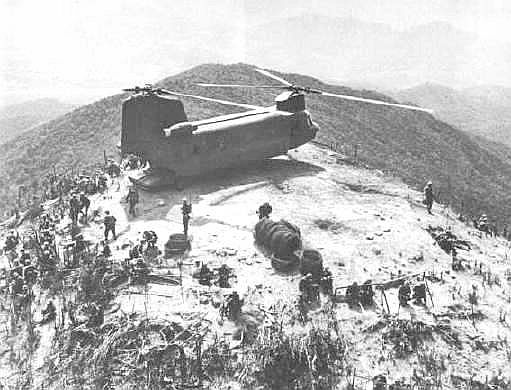
This is a 178th ASHC "Boxcar" Chinook on a mountaintop firebase LZ. (Uncredited photo "borrowed" from the 178th home page at http://www.boxcars.org/)
The ship was cranked up successfully, and we were off to Bronco. I thought that this is a bad start to my tour, and I only have 355 or so more days left. A short time later we arrived safe and sound at Duc Pho. In getting closer to Duc Pho, I saw that it wasn't right on the beach, but it was close enough for Government work.
As the Chinook was landing, there was a flight of Sharks taking off on a scramble departure north on the flight line. The Sharks bounced into the air. I was surprised that Army aircraft would be painted the way the Sharks were. They had those red and white teeth wrapped
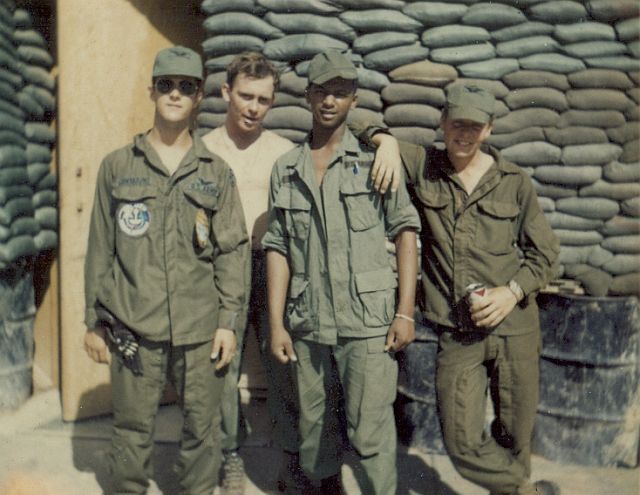 around the nose. The white tail fin. The Company stripe was on the tailboom and the access doors were painted with the logo of that particular ship. Pretty impressive. I was dropped off at POL (the refueling point) and walked to the 174th's Company area. I was assigned to the second Flight Platoon (Photo to the right: Tom is second from left. Others unknown).
around the nose. The white tail fin. The Company stripe was on the tailboom and the access doors were painted with the logo of that particular ship. Pretty impressive. I was dropped off at POL (the refueling point) and walked to the 174th's Company area. I was assigned to the second Flight Platoon (Photo to the right: Tom is second from left. Others unknown).
I was now part of the family known as the Dolphins and Sharks.
The 174th's Area of Operation (AO) ran to above Quang Ngai city to the north, the ocean to the east, the 2 Corp boundary to the south, and the Central Highlands to the west. The 174th supported the 11th Brigade, which consisted of Infantry Battalions of the 1/20 at LZ Liz NW of Bronco, the 4/3 at LZ San Juan Hill, the 4/21 which at the time was at an LZ SW of Bronco, and the 3/1 which if I recall correctly was at an LZ to the south of Duc Pho. We also supported the ARVNs (Army of the Republic of Vietnam soldiers) at Mo Duc and Quang Ngai city.
The first day I flew we were in the area of Quang Ngai flying Command and Control (also know as Charlie-Charlie or sometimes just C&C) for the ARVN's. We took fire. Being an FNG ("friendly" new guy), I didn't know what was going on and why all the shooting by the Crew Chief (I think it was Bud Van), and the "Taking Fire" call over the intercom scared the hell out of me.
Later in the week on a CA (Combat Assault), with "Mountain Yards" from the Special Forces (SF) camp at Ba-To we were putting the Yards in an LZ to the north of the camp. As the flight was lifting out of the LZ and climbing to altitude, one of the troops hadn't gotten off of ship, but was holding on to the skid underneath the gunner's well. Before the crew could get him into the ship, he fell to his death. When he hit the ground there was an explosion.
Since we were the trail ship, flight lead had us go down to retrieve the body. Our ship hovered above the area. I jumped out and recovered the body, which we returned to the SF camp. Apparently when he hit the ground, the LAW (Light Anti-tank Weapon) he was carrying exploded, which removed his head and upper body. The more I flew, I found that not getting off the ships, or hanging onto the skids,
would get to be a pattern with the ARVN troops who didn't want to leave the ships when they were
inserted into an area. I would get to dislike working with the ARVNs because of this.
I was finally assigned to fly on a UH-1H (I don't recall the tail number) with Armand Vallee being
the assigned crew chief. The next several weeks consisted of daily flying on CAs (Combat Assaults),
C&C's, resupply missions, and LRRP insertions and extractions. LLRP stands for Long Range
Reconnaisance Patrols. LLRPs were some really ballsy (or crazy) guys, doing some really ballsy
(or crazy) things. The ships would take fire periodically, but I don't recall any other ships being shot
down or crewmembers being shot during this time, other than the two Sharks that were shot down
in the area of OD Lake where two crewmembers were killed.
On one of the CAs in the area of the Gaza Strip (which was north of Duc Pho and east of the town of Mo Duc), the 174th picked up a Company of ARVNs at Mo Duc. It turned out to be a hot LZ. We landed after the artillery and gunship prep. The ARVNs started to unload. I saw a green flash go by from the right to the left in front of the ship. My first thought was "they have fast bugs here." Everyone started firing and yelling "taking fire" over the radios. As my helicopter lifted out of the LZ, the pilot asked what was holding his seat belt. I looked on the cargo deck and saw an ARVN who had apparently been killed as we landed, and was lying on his back. He was still holding the back to the pilot's seat belt. My "fast bugs," I was told, were tracers. In my short time in the Army, the only tracers I saw were red. I wish someone would have said something about green ones before then.
Finally, Vallee and I were assigned a new ship. It was a brand new UH-1H. It even had that new car smell. I think the number was 68-15567 [* Assistant Webmaster note: Actually, this aircraft he refers to was never in the 174th AHC (or the RVN for
that matter). We're researching the correct tail number]. The ship only had about 25 hours on it. Vallee and I began to paint the Company white and blue stripes on the tailboom and had just gotten the white painted. That afternoon we were assigned to an extraction of 1/20th Grunts* from a rice paddy area to the SW of LZ Liz. If I recall correctly it was a three-ship LZ. The flight had been in a couple of times and we were on one of the last flight. We were the trail ship, landing and taking off from the north to the south.
We picked up to a hover. The flight started to take fire from the right from the tree line. Fire was returned by us doorgunners, and the Sharks started to prep the area. As we were hovering at about three feet, our engine apparently was hit. It seemed to stall, and the ship hit the ground.
I continued to fire.
I looked and saw that everyone else had gotten off the aircraft, with the exception of me and a Grunt that had been shot and killed and was lying on the cargo floor. Now, this was a clue that I needed to do something…stay on?…get off?… The hell with it... GET OFF!
I jumped off the ship with my M16 in hand and was lying next to the ship by a rice paddy dike. I fired the magazine I had in the weapon. OOPS no more bullets. I could hear bullets hitting the ship.
SHIT!
I got up and tried to grab the bandoleer I had tied to the seat. Of course I couldn't get it untied. I could hear the tink, tink of more rounds striking the ship. Another valuable lesson learned: If you don't have it on you, you probably won't take it with you.
I'm going to start a list of things to do in the future...
I grabbed the bandoleer the Grunt had along with my M60 and what ammunition I could carry. The remaining Grunts and three crew members (Vallee, Lt Coakley I think, and an unknown pilot) were lying behind a dike about 25 yards to the left of the ship. They, at least, were smart enough to get away from a potential bomb carrying a thousand pounds of JP-4 jet fuel.
As I ran across the water filled rice paddy, I would sink up to about my knees in the mud with each step. I was finally able to get to the dike where the crew and the Grunts were located. As I fell across the dike into another water buffalo shit-filled rice paddy, the Grunt I was next to simply said, "That was neat". I asked him, "What?" He said, "As you was running across the paddy, that bullets were hitting around you and the water would splash up in the air just like in a John Wayne movie." Some movie! Where are my royalties?
* Incidentally, "Grunt" was a slang name given to the Infantry. I don't know where or how it was started, but I have nothing but respect for these guys.
The flight tried to get back in to drop off more Grunts and pick up the crew (us), but each time the flight tried to come in the fire increased. The flight was unable to land, even with the Sharks giving it everything they had trying to suppress the fire. Because of the fire, the Air Mission Commander (AMC) called for artillery support.
God knows how much firepower was expended, but eventually another flight of Grunts were brought into the area. By this time it was getting dark. We were running out of ammunition, and I wasn't looking forward to an overnighter without my blankee. The flight (I don't recall how many ships) finally was able to get in and drop off more troops, and to recover me and the rest of the crew.
Our Commanding Officer (CO), Major Goodin, was our savior. I was impressed. He could have assigned a junior officer to fly this dangerous mission-to get us out under fire--but he chose to personally fly in and get his crew out. I don't think the Grunts were too pleased to have to stay the night, expecially with our brand new (but now used and abused) helicopter, since it would be a target for the VC (Viet Cong) during the night. The next morning I was told that during the night that the VC had in fact been around our ship, and surprisingly enough the ship blew up. Every time I would fly in that area I would look at the only thing that was left of the ship, the tailboom with that new, bright, but unfinished white stripe.
Vallee and I were assigned another new ship. This one was 68-15644. The AC assigned to this ship was WO Heisinger (sp?). Vallee and I immediately got the company stripe and markings on the ship. We thought that only getting the job partially done was a bad omen because of our last experience, and we didn't want to tempt fate again. We then continued to fly our assigned missions.
I think the most satisfying flights were the extractions, taking Grunts out of the field, and the re-supply missions for the Grunts. Every time we would land at their logger position, they would come up to us as the ship was being unloaded and give us handfulls of mail. At the time I was wearing jungle fatigues, so I would stuff the mail in the pockets. By the end of the day I would look like the Pillsbury Doughboy with all the mail that I was carrying.
Sometime around June or July 1969, the 174th and the Blackcats (282nd AHC) from DaNang were involved in the largest CA that I had been involved in to this date. I don't recall the number of ships, but this assault involved the ARVNs to be inserted along the river west of Quang Ngai city. This area had been worked by the ARVNs prior to this. Our ship was in either the second or third lift into the LZ. Each flight would land from the west to the east, with a "break right" once out of the LZ. The lead flight consisted of the Blackcat aircraft.
As the lead Blackcat exited the LZ, they started receiving heavy fire as the flight was climbing. I watched the lead flight climb to altitude. The lead ship started to climb nose high, then rolled to its left, inverted with the nose down, and continued to roll and fall to the ground, killing the entire crew. As the ship rolled, one of the crewmembers fell from the aircraft. A pilot attempted to call lead on the radio to tell him that he had an aircraft going down. Another pilot simply said, "That was lead."
We continued to insert troops into the LZ but, on leaving the LZ we broke left over the river. We still took fire. I don't recall how many ships had been shot up or other casualties in this assault, but it was a bad day.
In August 1969, Dolphin #644 was assigned to a flight of Dolphin aircraft involved in a CA with 4/3 Infantry, to insert troops into an LZ in the "515 Valley" area. The flight was headed towards the LZ. Dolphin #644 was in front of the trail ship (second to last). The flight started to receive .51 cal. (anti-aircraft) fire. The trail ship, Dolphin UH-1H 66-00993, with a crew consisting of WO Shields, WO Bozinski, Sp4 DelValle, and PFC Graham, plus six Grunts had been hit, severing the tailboom. What a helpless feeling. All I could do was watch as the pilot tried to control the ship as it fell. The crew and all the Grunts were killed.
Below is a dramatic pen-and-ink drawing of Dolphin #993 being shot down that Tom witnessed.
Original drawing by Ben Kennedy.
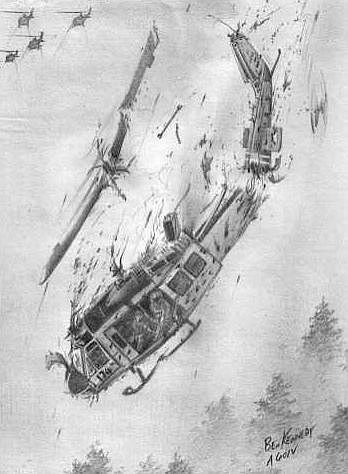
The remaining Grunts were inserted, and they located the .51 cal and its gunner. The kid (I was told was 12 years old) had said that he had also shot down the Shark aircraft in the area of OD Lake earlier in the year.
Watching helicopters fall from the sky and friends being wounded or killed would become a common sight as I continued my tour.
Sometime in the summer/fall of 1969, a company of 1/20th Grunts ran into some larger booby-trapped mines or bombs just north of LZ Liz and close to Highway 1. Dustoff (a medical evacuation helicopter marked with the red crosses) had gone in to pick up the wounded. As the Grunts were bringing their wounded to the ship another booby trap was detonated, causing the Dustoff to overturn in the LZ. Several Dolphin aircraft were sent to the location to evacuate the wounded and dead from the LZ. We had made several trips between the LZ and the Medevac pad at Duc Pho.
During this summer and fall, I remember several times when we would pick up wounded from the Grunt units in the field, and that we would actually have to wait in line at the hospital at Duc Pho. The ships in front would offload the wounded and we would work our way forward in the queue to do the same, then we would go back and repeat this process for other units in contact.
The 3/1 moved into LZ Hill 411 around July or August 1969. This area would cause our Company several wounded or killed in the upcoming months. Dolphin #644 was assigned to a mission for 3/1. I didn't fly that day. Armand Vallee was the crew chief. I think Scott Sparks was the gunner. Later in the morning, I was told that Vallee had been shot and was taken to Evac Hospital at Chu Lai. The next day I flew to Chu Lai and visited Armand. He was in good spirits and had his million dollar "get to go home" wound. A short time later Armand was sent home. At that time, Armand had been in County for about four to five months.
It was sort of ironic. As I was getting a ride home from Chu Lai to Duc Pho and we were passing over Quang Ngai city, guess what? Green tracers were coming up to greet us from the city. Nice place, maybe I'll buy a condo there.
I was then assigned Dolphin 644 for the duration.
The 3/1 was assigned a new AO, and it had a particularly nasty section that was called the Horseshoe. I think this area had more NVA living there than there were in Hanoi. I seems like the 174th spent more time flying in this area than all the other areas combined, and you could always count on being shot at.
A flight of Dolphin aircraft were headed towards Hill 411 from Duc Pho to pick up a company of Grunts for a CA. The flight was just south of getting to the 3/1 area. There was an Air Cav unit, either the Blue Ghost or Warlords, headed west into the Happy Valley area. Their Blues, in a Huey, was at about the same altitude as us, and was crossing in front of our flight. Their transmission apparently seized up. The blades just came to a stop and the aircraft simply tumbled to the ground, killing the crew and the Blues on board. The area was secured with a load of Grunts, and we flew to Hill 411 to get body bags so the remains could be recovered.
Another day the 174th was to insert a company from the 3/1 into a CA at the south end of the horseshoe, in the mountains. The LZ was on a plateau and would accommodate 3 ships. This plateau had a drop-off of about 1000 feet at the north end of this particular LZ. The flight would land from south to north. The North Vietnamese Army (NVA) and the VC, in true fashion, allowed the first couple of flights to land and offload the troops. The next flight started to take .51 cal fire from the SW.
While the Sharks dealt with that threat, it was decided to land single-ship from the north to the south, with a shallow approach, to get the remaining grunts on the ground. Naturally there weren't any other sites that we could land at in the area. The wind was not in our favor and as we made the shallow approach to the LZ, there was a severe downdraft that was trying to suck the ship down the side of the cliff. We only partially made it onto the LZ.
Our front skids were on the edge of the cliff, with everything from the pilots seats back being in the air. As the AC (I don't recall who was flying that day) struggled to get the ship onto the LZ, the ship was bouncing on the edge. The Grunts (and yeah I admit I didn't want to be on this thing either) would look at the thousand foot fall, then look at me, the front skids bouncing on the edge within an arms
reach--but so so far away. Finally the AC was able to slide the ship over the edge, onto the LZ.
The Grunts unloaded, we picked up did a pedal turn, and departed back to the north. The AC let flight lead know that we had an overtorgue and we would be going to Hill 411 or Quang Ngai. Maintenance was contacted, and we shut down until the Witch Doctor (the 174th's Maintenance Officer) arrived. Dolphin #644 got its first free sling-ride home, compliments of the 178th Boxcars. I guess when the gauge is going around for the second time, and the needle is bent, that would qualify as an overtorque.
Dolphin 644 was repaired and was assigned to a re-supply mission for the 4/21 in the hills to the west of the rice bowl. As the ship was climbing to altitude, the Grunts on the ground called and informed us that we had a 105 mm artillery round on our left rear skid.
Say What?
These guys must be messing with us…BUT…maybe we should otta check anyway. So in taking a scrutinizing gander at the left rear skid, where the alleged round was suppose to be located….SHIT….There was a indeed 105 round dangling from the left rear skid. The round was hanging nose down with a loop of wire of some sort around the bottom of the round. This wire was looped around the end of the skid. Let's examine our options:
1 - It's a dud, ignore it. -- Nah, that won't work.
2 - Kick it! --Nah, another dumb idea.
3 - Land or hover and have someone take it off. -- Problem: to find a volunteer, then hope it doesn't go bang when it's touched. Nah, that might not be the best solution either.
4 - Maybe it will just fall off on its own. -- Nah, not likely.
5 - Someone will have to climb out on the skid while we hover at altitude and cut the wire. -- Huh?? -- OK, OK, sir, I get the message!
I got a pair of cutters, and when the ship was at a hover at about 1000 feet, I stepped out onto the skid while holding onto the gun rack. I found that the round looked fairly old, a dud?…so far at least… And it wasn't a wire. When the round was fired, it shaved off the end of the round, and that "shaving" was partially attached to the end of the round. Apparently, as the ship lifted from the LZ, the rear of the skid dug in the dirt and the round hooked onto the skid. In any event, the metal cut fairly easily and the round fell the thousand feet to the ground. We continued our mission.
OK gang, it's time for a quiz: The question is... Is it possible to fly a UH-1H underneath the Quang Ngai bridge?
The answer is... Yes.
One sunny day while flying a MACV C&C... Naw, never mind. Better not tell -- think I'll just move on.
In November 1969, Dolphin 644 was on another MACV C&C, and we had flown to Chu Lai. We were sitting on the maintenance pad when a Dolphin first platoon ship landed. I think they were either on a 3/1 C&C, or re-supply. I spoke to Forrest Hodgkin briefly. His ship was using free guns--M60's without gun mounts. I don't know why they didn't have gun mounts like all of the other Dolphin aircraft, but they didn't. They left Chu Lai on their mission. Later that day, we were told that they had been shot down in the Horseshoe area on a re-supply mission, killing the crew consisting of Hodgkin, WO Wilson, WO Regaldo and Sp4 Ducommon. I often wondered if not having visible guns on the ship may have contributed to their shoot down.
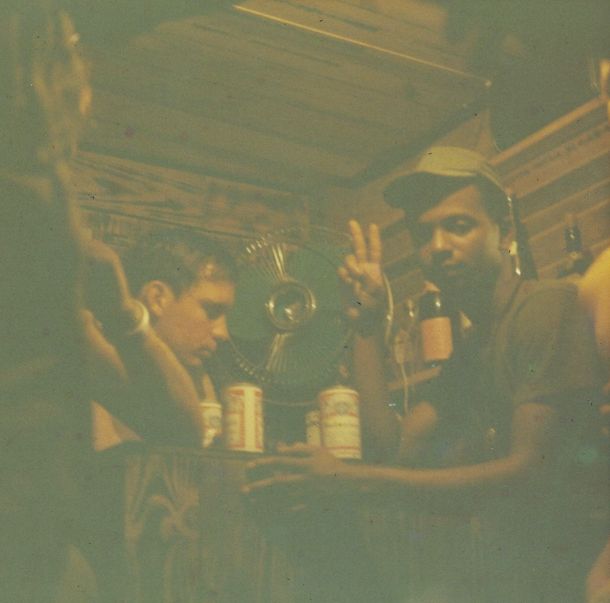
Tom’s Hootchmate in mid-1969 was SP5 Jim Shedd. Shedd offered us the photo
above. “This overly exposed (but very important) photo is of the bar in our room (Tom Taggart and
mine) it was quite a set up: a small bar with refrigerator, two fans, C-rats and LRRPs food, it was the
center of social life in the 2nd Platoon. People would drop by, spend time, drink, tell war stories,
laugh and overall an excellent location for good camaraderie. That's Taggart second from left." - Jim Shedd
------------------------
End of Part 1 of 2 Parts.
Click on the beacon to go to Part 2

|



![]() to e-mail us at the website
to e-mail us at the website ![]() Return to top of the Biography Page.
Return to top of the Biography Page.![]() Return to top of: Home Page.
Return to top of: Home Page.
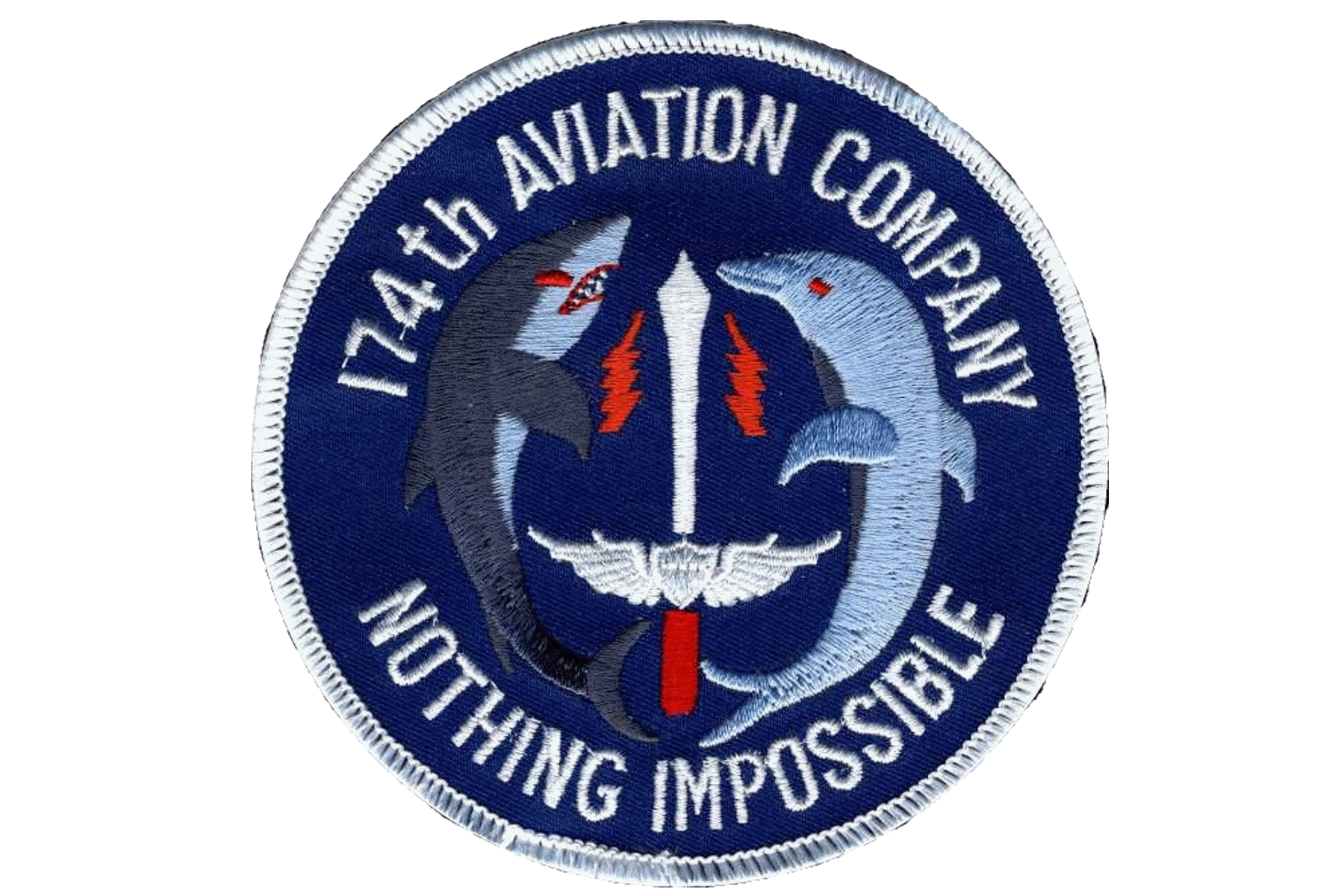
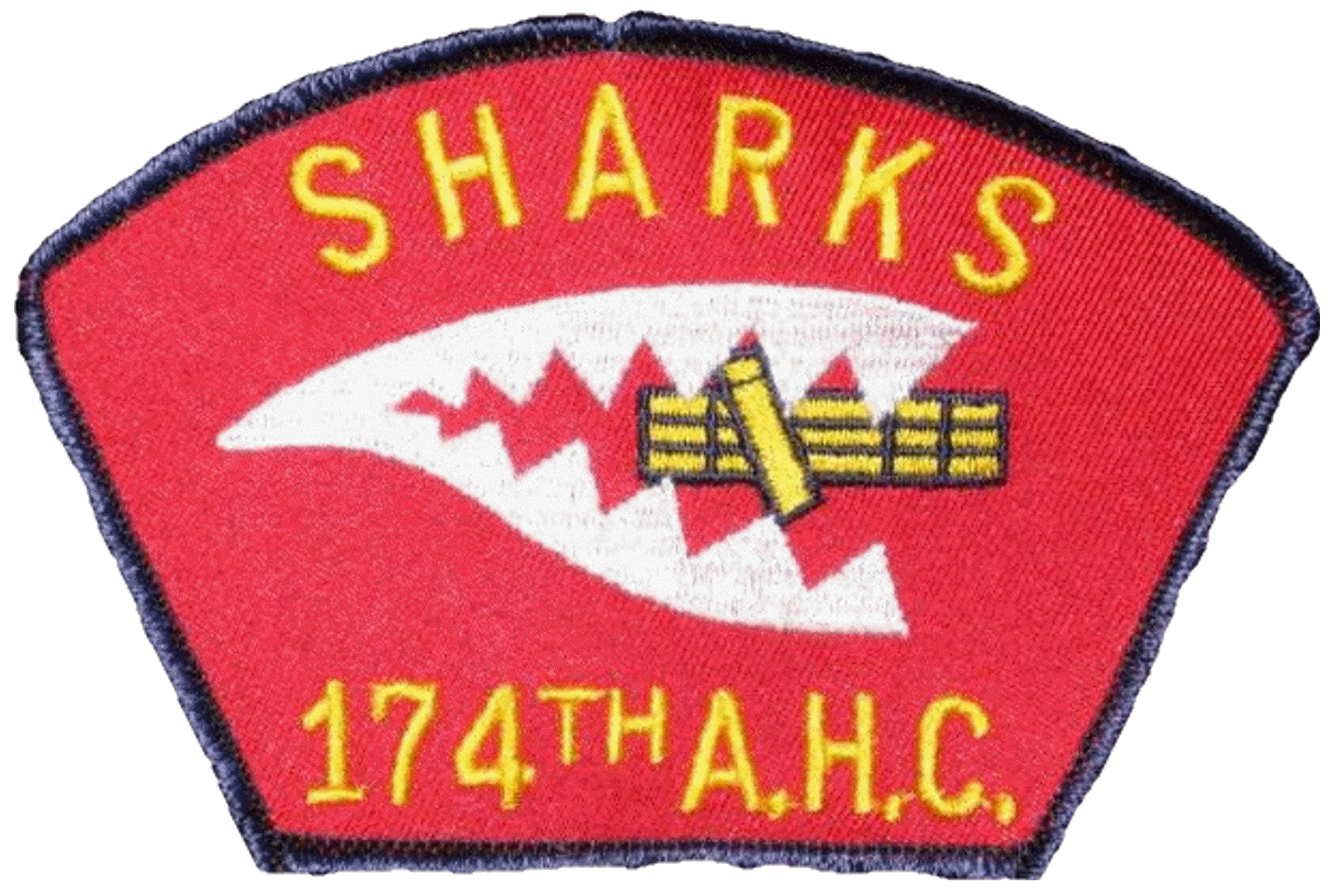
 I was processed in-county, then I was assigned to the 23rd Infantry Division (Americal) at Chu Lai. Of course, not from being around there, I ask, "Where is or what is a Chu Lai?" I was simply told it was up north and I could find it on the map. Well I let my fingers do the walking and I finally did find Chu Lai (or Chicken Little as it was more often called). I thought, this isn't bad. It's on the beach. This is going to be a piece of cake. Being in my own little delusional world, I didn't consider the fact that I might not actually spend my time at Chu Lai--on the beach.
I was processed in-county, then I was assigned to the 23rd Infantry Division (Americal) at Chu Lai. Of course, not from being around there, I ask, "Where is or what is a Chu Lai?" I was simply told it was up north and I could find it on the map. Well I let my fingers do the walking and I finally did find Chu Lai (or Chicken Little as it was more often called). I thought, this isn't bad. It's on the beach. This is going to be a piece of cake. Being in my own little delusional world, I didn't consider the fact that I might not actually spend my time at Chu Lai--on the beach. around the nose. The white tail fin. The Company stripe was on the tailboom and the access doors were painted with the logo of that particular ship. Pretty impressive. I was dropped off at POL (the refueling point) and walked to the 174th's Company area. I was assigned to the second Flight Platoon (Photo to the right: Tom is second from left. Others unknown).
around the nose. The white tail fin. The Company stripe was on the tailboom and the access doors were painted with the logo of that particular ship. Pretty impressive. I was dropped off at POL (the refueling point) and walked to the 174th's Company area. I was assigned to the second Flight Platoon (Photo to the right: Tom is second from left. Others unknown).